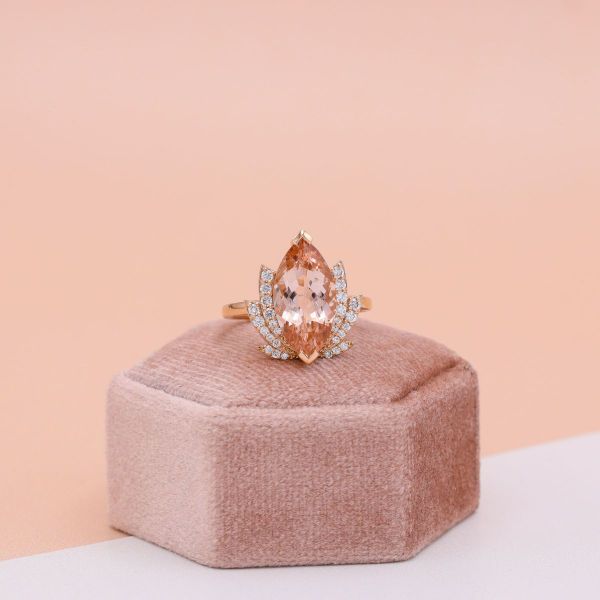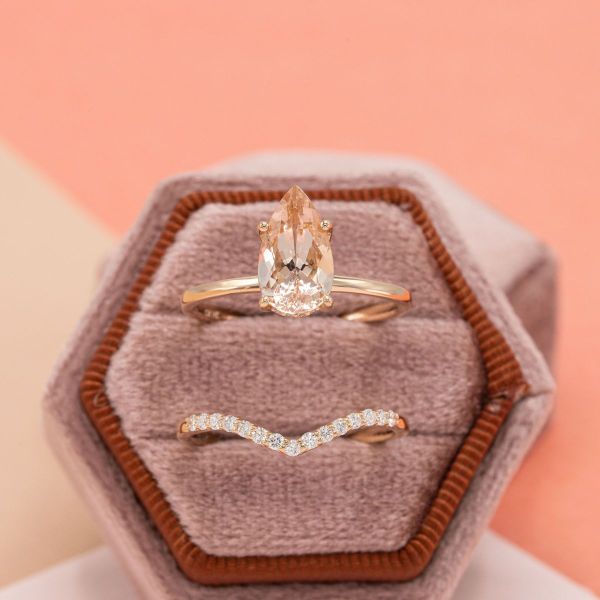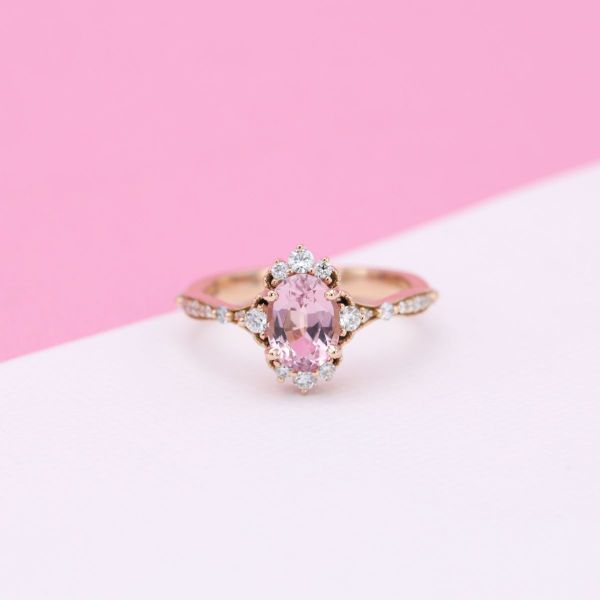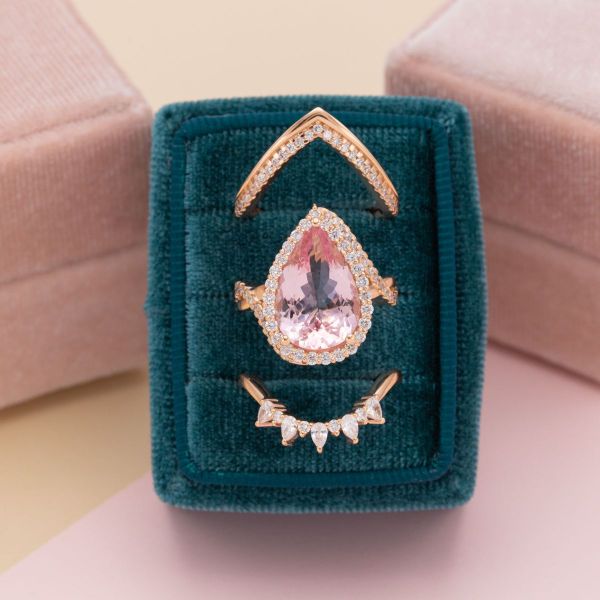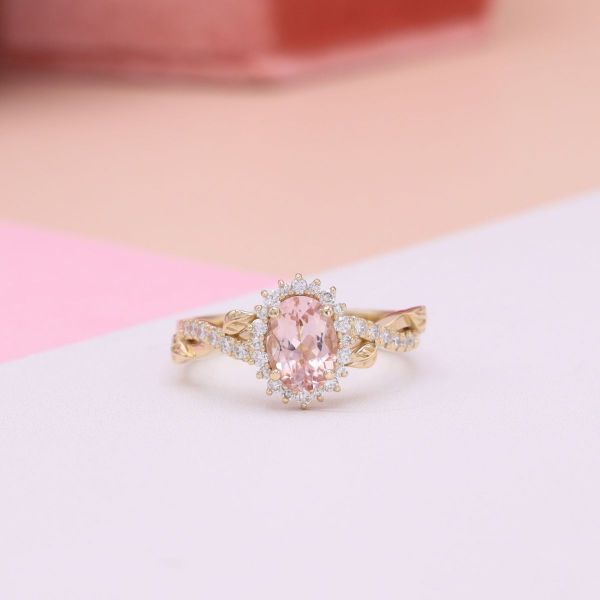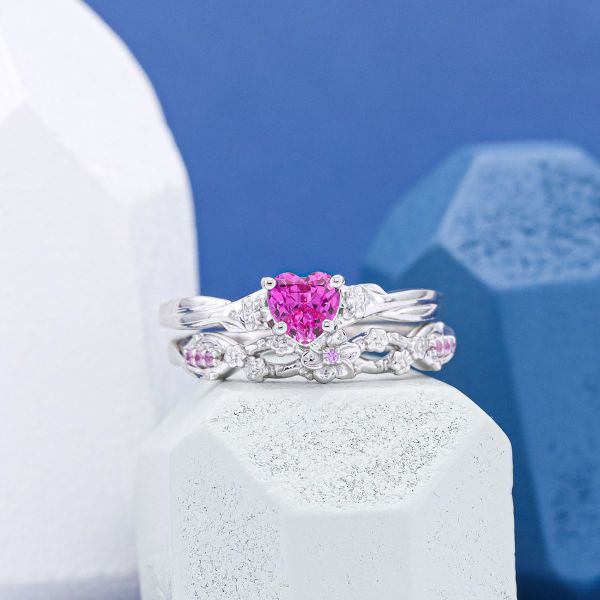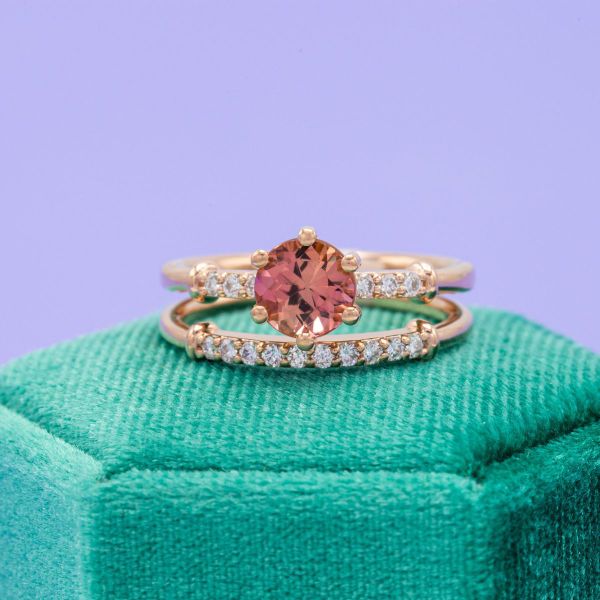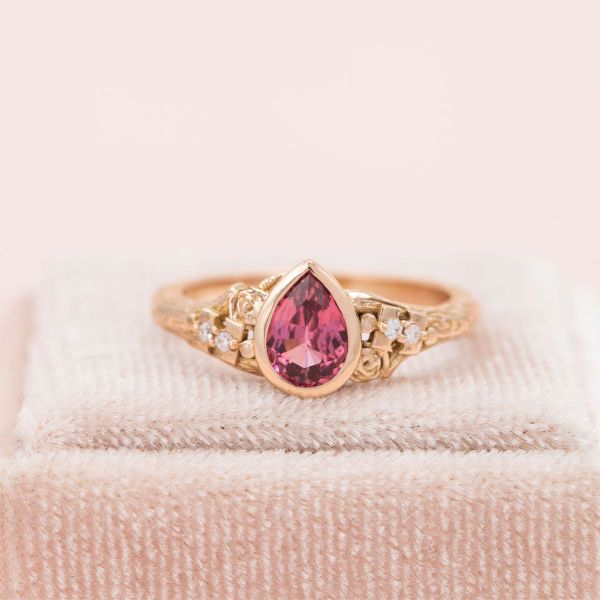Gemstone Knowledge
What color is morganite?
Perusing morganite’s color options
Shades of pink and peach
Pink Floyd, the Pink Panther, the cult classic Pretty in Pink: if you’re feeling inspired by all these rosy references, we can see why you’re considering morganite for your engagement ring! With soft, blush hues that range from pink to peach, morganite will have you wanting to wear pink on more than just Wednesdays (where are my Mean Girls fans at?). There’s plenty to learn about this popular stone’s color, so let’s take a closer look at morganite’s signature shades and the factors that influence them.
A deeper look at color: hue and saturation
We can’t talk about morganite’s color without discussing hue, saturation, and tone. While we go into deeper detail in our gem color article about what each of these three facets mean, hue and saturation are the most important two to consider when looking at morganite.
Hue
Hue refers to the specific color of a stone: is it pink, blue, green, or something entirely different? For morganite, when we’re talking about hue that’s going to be shades of pink!
Morganite ranges from velvety light pink—think like the petals of a blush rose—to peachier shades that remind us of champagne and rosé with the same bright, bubbly personality. In addition to pure pink and pure peach variations, some morganites even sport a more violet tinted color with purplish pink appeal. Morganite’s various hues can also be warm or cool in nature, with many couples preferring a happy medium in peachy pink varieties similar to rose gold.
Saturation
Saturation is the other area where you’re going to find variation in morganite’s color, referring to the intensity or richness of its hue. Think of saturation as food coloring in water: if you have two cups of water and place three drops of food coloring in one and nine drops of the same color in the other, the one with more food coloring will have a stronger, saturated color even though both cups have the same hue. Stones with strong or vivid saturation offer deep, vibrant color, whereas stones with a light saturation have a more translucent color.
There are a surprising number of saturation levels to choose from when it comes to morganite! On a saturation scale of 1 to 5, you can find morganites in the 1 to 4 range with hues varying in intensity from light to strong. Some stones have very light saturation and produce a pastel or pale hue, while others feature a vivid pink color thanks to their strong saturation. The same goes for peach varieties as well, which can range from a soft champagne to a brighter peach hue.
Many couples prefer morganites with higher saturations—which tend to be the most prized coloration—but others adore the subtle beauty of lightly saturated stones! But with that being said, there’s no right answer when it comes to saturation! It's all about finding the look that's right for you.
Other color factors to consider
Size and clarity
Did you know the size of your morganite can actually impact its color? But, unlike some colored gemstones where smaller stones tend to have more concentrated color, larger morganites actually display more vivid color than smaller stones! This is because larger morganites offer more opportunities for light to enter the stone and strengthen color as it bounces around.
Because of morganite’s open tone and soft hues, it also shows inclusions more easily. While some small inclusions won’t affect visual appeal, larger ones can potentially impact overall color in a visible way. However, morganite is a generally clean stone with few visible inclusions, and here at CustomMade we handpick eye-clean stones for your review.
Heat treatment
Before it reaches its final destination on your finger in a one-of-a-kind engagement ring, morganite often receives heat treatment and is exposed to intense temperatures similar to those experienced during its formation. This heat treatment doesn’t impact the structure or inherent value of morganite, but it does improve the color to create a more desirable stone in the process. It does so by removing the yellow undertones common in morganite, producing a purer pink hue and more of those highly prized medium to strong pink colors.
Think of these heat treatments as a spa day for your morganite, where it spends a little extra time in the sauna to foster lovely color and glow so it can become its best self. In the end, heat treatment makes more morganites with high-quality color readily available for you!
Morganite accent stones
Thinking of using morganites as accent stones in your engagement ring? While morganite’s pink and peach hues may seem like perfect accents for a diamond ring, you probably won’t notice much of their color in small stones. Because morganite’s color is naturally light, it becomes extremely light when used as accent stones. As such, you might want to up the size of those stones so the color is more apparent or be totally cool with a toned down version of morganite's already light hue.
Pink and peach alternatives
Pink sapphire
A popular choice for engagement rings, pink sapphires have a slightly more violet-pink hue with saturated color when compared to light morganite, offering a more vivid pink appeal. Their corundum structure also means they’re extremely durable, coming in at a 9 on the Mohs scale—just below diamonds at a perfect 10!
Pink sapphires symbolize loyalty, trust, and sincerity, making them a perfect symbol of your lifelong commitment to your partner. Sapphire is also a September birthstone, making it an ideal choice for partners with September birthdays or couples with anniversaries during this month. They’re a bit more expensive than morganites, but the enhanced durability and rich pink color are worth it for couples looking for a brighter pink stone.
What’s more, lab-created sapphires can provide even more pinky-peach varieties for you to choose from. Ranging from light and pink champagne hues to bubblegum and vivid pink to the rich orange-pink of Padparadscha sapphires, lab-created stones are genuine sapphires produced in a controlled environment and cost less than their natural counterparts.
Pink tourmaline
Pink tourmaline is a versatile and affordable alternative to morganite, and at a 7-7.5 on the Mohs scale it can definitely stand up to the daily wear of an engagement ring. Tourmaline comes in many colors with pink and green being the most common shades you’ll find. Pink tourmaline doesn’t just produce one hue, but rather there are several varieties of pink you may find with this versatile stone, such as magenta, baby pink, rose pink, and even hot pink. There are even stones with both pink and green colors, known as–you guessed it–watermelon tourmaline! Pink tourmaline is also the modern birthstone for October, so if your partner has an October birthday then it may be the perfect sentimental stone for their engagement ring!
Pink spinel
Pink spinel is a pink-lover’s paradise with hues that range from light to hot pink. With descriptors like bubblegum, hot, and neon, the pink options for spinel are vibrant and eye-catching as center stones. Plus, it rates at an impressive 8 on the Mohs scale, meaning pink spinel is also a durable choice for engagement rings and can handle daily wear. Pink spinel is an affordable alternative to morganite that will leave others positively pink with envy!
Summing up morganite’s color
So what do you think about morganite now that you know a little more about its color? If you’re obsessed with trendy pink and peach hues, there’s nothing quite like a morganite center stone for your engagement ring. Even though morganite only comes in a few colors, the possible combinations of hue and saturation can provide a surprising variety to choose from! As such, it can be helpful to take a look at plenty of morganites before making any major decisions.
About CustomMade
CustomMade designs and creates one-of-a-kind, custom engagement rings and fine jewelry. Each piece we create is inspired by you, designed for you, and made just for you.
